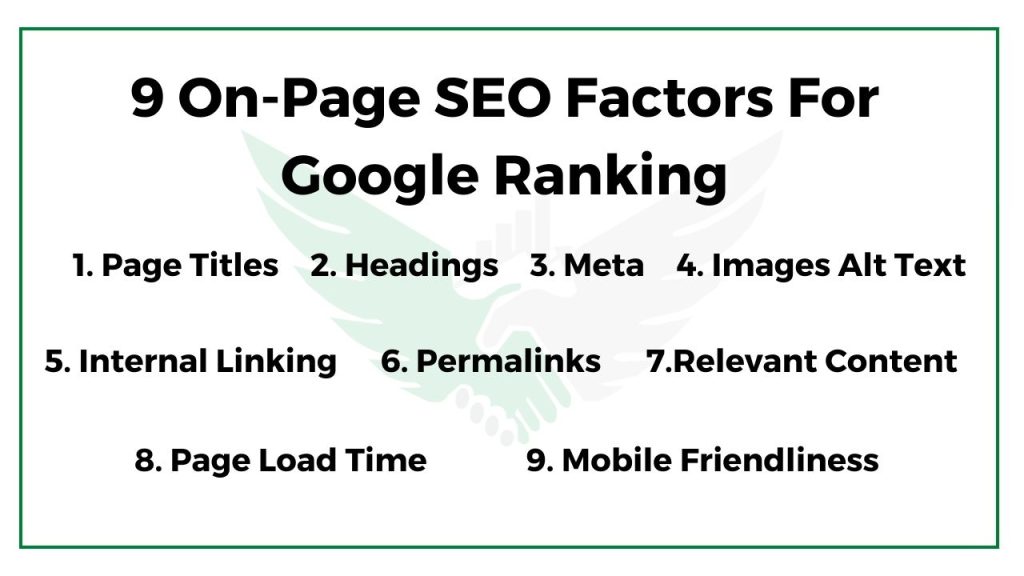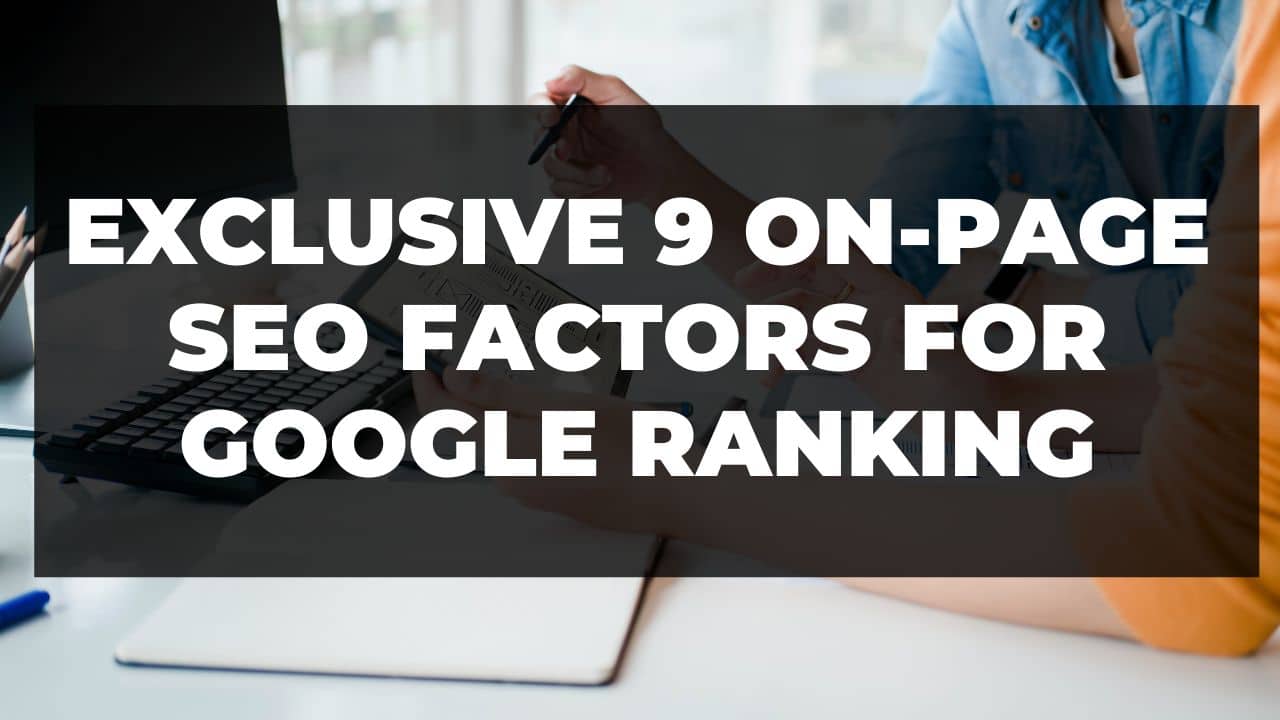On-page SEO factors for google ranking refer to optimizing each individual web page to rank higher and get more relevant traffic in search engine results. This can be achieved by improving the web page’s content and HTML source code.
Exclusive 9 On-page SEO factors for google ranking to consider include:

Page titles
The first On-Page SEO Factors For Google Ranking is the title of a page is one of the most important on-page SEO factors. It should accurately reflect the content of the page and include the main keywords you want the page to rank for.
In search engine optimization (SEO), the title tag of a webpage is the HTML element that specifies the content of the title of a webpage. The title tag is typically displayed in the search engine results pages (SERPs) as the clickable headline for a given result and is important for usability, SEO, and social sharing.
The page titles should be no longer than 70 characters, including spaces, and should include the primary keyword or phrase for which the page is being optimized.
The title tag is an important factor in SEO because it tells search engines what the page is about and helps them to understand the content and context of the page. It also helps to improve the click-through rate (CTR) of the page in the search results, as a descriptive and relevant title is more likely to attract clicks from users. A well-written title tag can help to increase the visibility of the page and make it more appealing to users, leading to more clicks and higher engagement.
Headings
The second On-Page SEO Factors For Google Ranking is the headings. Headings (H1, H2, etc.) help structure the content of a page and make it easier for users and search engines to understand the main points. Use relevant and descriptive headings for your content and try to include your main keywords in at least one of them.
Headings are an important element of web page content and can play a significant role in search engine optimization (SEO). They help to structure and organize the content of a page and can also be used to signal the hierarchy of information to search engines and users.
Here are some best practices for using headings in SEO:
- Use headings to organize and structure your content: Headings help to break up large blocks of text and make it easier for users to scan and understand the content. They also help search engines to understand the structure and hierarchy of the content on the page.
- Use relevant and descriptive headings: Headings should accurately describe the content that follows and should be relevant to the overall theme of the page. Avoid using vague or non-descriptive headings, as they may not be helpful to users or search engines.
- Use a hierarchy of headings: Use heading tags (H1, H2, H3, etc.) to indicate the hierarchy of your content. The H1 tag is the most important and should be used for the main heading of the page. Subheadings can be marked with H2, H3, and so on.
- Use keywords in headings: Including keywords in headings can help to signal to search engines what the page is about and can also help to improve the relevance and visibility of the page in the search results. However, it is important to use headings naturally and avoid overloading them with keywords.
- Keep headings concise: Headings should be concise and to the point, typically no longer than 70 characters, including spaces. This helps to ensure that they are displayed properly in the search results and are not truncated.
Meta descriptions
The third On-Page SEO Factors For Google Ranking is the meta description is a brief summary of the page’s content that appears in the search results. It should be compelling and accurately describe what the page is about, as it can influence whether a user clicks on your result or not.
In search engine optimization (SEO), the meta description is an HTML attribute that provides a brief summary of the content of a webpage. It appears in the search engine results pages (SERPs) under the title of the page and is meant to give users an idea of what the page is about and make it easy to decide whether click or not on the result.
Meta descriptions are not a ranking factor for search engines, but they can still be an important part of SEO. A well-written meta description can help to improve the click-through rate (CTR) of a webpage in the search results, as it can make the result more appealing and relevant to users.
To write a good meta description, keep it concise (no more than 160 characters, including spaces), include relevant keywords, and make it descriptive and compelling. Avoid using vague or non-descriptive meta-descriptions, as they may not be helpful to users or search engines.
It is also important to note that search engines may choose to ignore the meta description and display a different snippet of text from the page in the search results. This can happen if the meta description is not relevant or does not accurately reflect the content of the page.
Images and alt text
The fourth On-Page SEO Factors For Google Ranking is using relevant images and including alt text (a short description of the image) can help improve the user experience and can also help with SEO. Alt text is also used by screen readers to help visually impaired users understand the content of an image.
Using images and alt text can be an effective way to improve the search engine optimization (SEO) of a website. Here are a few ways in which images and alt text can help with SEO:
- Alt text: Alt text is a short piece of text that is used to describe an image on a webpage. It is displayed in place of the image if the image cannot be displayed for any reason (e.g., due to a slow internet connection or a screen reader being used). Alt text is important for SEO because it helps search engines to understand the content and context of the image, which can improve the relevance and visibility of the page in the search results.
- File names: Using descriptive and relevant file names for images can also help to improve their SEO value. For example, if you have an image of a red car, a descriptive file name like “red-car.jpg” would be more helpful to search engines than a generic file name like “image1.jpg.”
- Image size: Using large or high-resolution images can slow down the loading time of a webpage, which can negatively impact its SEO. It is important to optimize images by compressing them and using the appropriate size for the intended purpose.
- Image context: Using images that are relevant to the content of the page and using them in a way that adds value to the user experience can also help with SEO. For example, using images to illustrate a point or to break up large blocks of text can make the content more engaging and easier for users to understand.
Overall, it is important to use images and alt text in a way that adds value to the user experience and helps search engines to understand the content and context of the page.
Pages Internal linking
The fifth On-Page SEO Factors For Google Ranking is the web page’s Internal linking is the process of linking to other pages on your own website. It helps users and search engines navigate your site and can also help improve the SEO of individual pages.
Internal linking is the process of linking one webpage to another within the same website. It is an important aspect of search engine optimization (SEO) because it helps to improve the navigation and usability of a website and can also help search engines to understand the content of the website.
There are several benefits to using internal linking in SEO:
- Improved navigation: Internal linking helps users easily find and access other pages on the website, improving the overall user experience.
- Increased dwell time: When users click on a link and stay on the website to read or explore other pages, it can increase the dwell time on the website, which is a positive signal to search engines.
- Enhanced indexation: Internal linking can help search engines to discover and index more pages on the website, which can improve the visibility of the website in the search results.
- Enhanced authority: Internal linking can help to distribute link equity (ranking power) within a website, which can help to improve the overall authority of the website.
To effectively use internal linking for SEO, it is important to use descriptive and relevant anchor text (the clickable text in a link), link to relevant and high-quality pages, and use a logical and hierarchical linking structure. It is also important to avoid overusing or misusing internal linking, as it can have a negative impact on the user experience and the overall SEO of the website.
URLs / Permalinks
The sixth On-Page SEO Factors For Google Ranking is the use of descriptive, keyword-rich URLs for your web pages. Avoid using long, complicated URLs or permalinks with unnecessary parameters.
A permalink is a permanent URL that is used to access a specific webpage or piece of content on a website. In search engine optimization (SEO), permalinks can be an important factor because they help to identify the content of a page and can also affect the visibility and ranking of the page in the search results.
Here are a few best practices for using permalinks in SEO:
- Use descriptive and relevant permalinks: Permalinks should accurately describe the content of the page and should include relevant keywords. This helps search engines to understand the content of the page and can improve its relevance and visibility in the search results.
- Keep permalinks short and concise: Long and complex permalinks can be difficult for users to remember and can also be less effective for SEO. It is generally best to keep permalinks as short and concise as possible while still accurately describing the content of the page.
- Use hyphens to separate words: Many search engines treat hyphens as word separators, so using hyphens in permalinks can help to improve their readability and SEO value.
- Use static permalinks: Dynamic permalinks (URLs that contain a series of numbers or variables) can be less effective for SEO because they are less descriptive and can change frequently. It is generally best to use static permalinks that are consistent and do not change.
Overall, it is important to use descriptive and relevant permalinks that accurately reflect the content of the page and are easy for both users and search engines to understand.
Content
The seventh On-Page SEO Factors For Google Ranking is the content on your pages should be unique, informative, and engaging. It should provide value to the user and address the intent behind the search query. It should be without spelling or grammar mistakes. You can either use a free tool called Grammarly to rectify your content from grammar or spelling mistakes.
Creating content according to search engine optimization (SEO) guidelines can help to improve the visibility and ranking of a website in the search results. Here are some of the important tips for creating SEO-friendly content:
- Use relevant and targeted keywords: Identify the keywords that are relevant to the content of the page and include them in the content in a natural and organic way. Avoid keyword stuffing (overusing keywords in an unnatural or spammy way).
- Write high-quality, unique, and useful content: Search engines prioritize high-quality, unique, and useful content. Make sure to research and write content that is informative, engaging, and provides value to the user.
- Use headings and subheadings: Use headings and subheadings to structure and organize the content of the page and make it easier for users to scan and understand. Use relevant and descriptive headings and include keywords when appropriate.
- Use images and alt text: Include relevant images in the content and use alt text to describe the images and help search engines understand the content and context of the page.
- Use internal linking: Link to other pages on the website to provide additional context and information for users and to help search engines understand the structure and content of the website.
Overall, the key to creating SEO-friendly content is to focus on creating high-quality, useful, and relevant content that provides value to users and helps search engines to understand the content and context of the page.
Page load time
The eighth On-Page SEO Factors For Google Ranking is the page load time. Page load time is one of the important On-page SEO factors for google ranking that can influence the user experience and can also impact SEO. Try to keep your website load time as low as possible. If you’re using WordPress then recommended using fewer plugins or scripts to keep your website faster in load. (e.g WP Rocket, WP Fastest Cache, Litespeed Cache, W3 Total Cache, WP Super Cache)
Page load time is an important factor in search engine optimization (SEO) because it can affect the user experience and the ranking of a website in the search results. Search engines prioritize websites that provide a good user experience, and fast page load times are an important part of that experience.
Here are a few ways to improve page load time for SEO:
- Optimize images: Large or high-resolution images can significantly increase the size and load time of a webpage. Optimize images by compressing them and using the appropriate size for the intended purpose.
- Use a content delivery network (CDN): A CDN is a network of servers that delivers web content based on the geographic location of the user. Using a CDN can help to reduce the load time of a webpage by serving content from a server that is closer to the user.
- Minimize the use of JavaScript and CSS: Excessive use of JavaScript and CSS can increase the load time of a webpage. Minimize the use of these technologies and consider combining and minifying them to reduce the size and load time of the webpage.
- Enable caching: Enabling caching allows a webpage to be stored in the user’s browser, so it does not have to be loaded from the server every time the user visits the page. This can significantly reduce the load time of the page.
Overall, it is important to optimize the page load time of a website to improve the user experience and the ranking of the website in the search results.
Mobile-friendliness
The last On-Page SEO Factors For Google Ranking is the increasing number of users accessing the web from mobile devices, it’s important to make sure that your site is mobile-friendly. Google’s “Mobile-first Index” means that the mobile version of your site is used to index your pages for ranking.
In addition to these on-page SEO factors, it’s also important to consider off-page SEO factors, such as the quality and quantity of backlinks from other websites.
Mobile friendliness is an important factor in search engine optimization (SEO) because more and more users are accessing the internet from mobile devices. Google uses mobile-friendliness as a ranking factor, so it is important to ensure that a website is optimized for mobile users in order to rank well in the search results.
Here are a few ways to make a website mobile-friendly for SEO:
- Use responsive design: A responsive design ensures that a website looks and functions properly on different devices and screen sizes. This is important because it allows users to easily access and interact with the website regardless of the device they are using.
- Use a mobile-friendly design: A mobile-friendly design is optimized for the smaller screens and touch-based interfaces of mobile devices. It should be easy for users to navigate and interact with the website on a mobile device.
- Optimize images and other media: Large or high-resolution images and videos can significantly increase the load time of a webpage on a mobile device. Optimize these elements by compressing them and using the appropriate size for the intended purpose.
- Use mobile-friendly forms and buttons: Make sure that forms and buttons are easy to use on a mobile device and are large enough to be easily tapped with a finger.
Overall, it is important to optimize a website for mobile devices in order to provide a good user experience and improve the ranking of the website in the search results.
Summary
To summarize, on-page SEO is the process of optimizing individual web pages to rank higher and earn more relevant traffic in search engines. It involves optimizing the content and HTML source code of a page, as well as ensuring that the page is mobile-friendly and has a fast loading speed. On-page SEO is important for both users and search engines, as it helps improve the user experience and makes it easier for search engines to understand the content of a page.
Read more about why your website never ranks (Top 5 Reasons)














